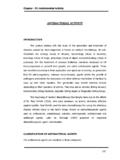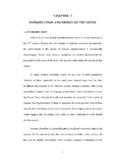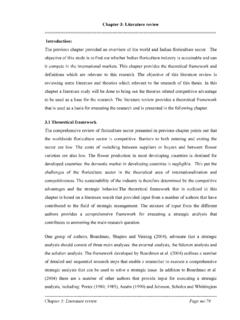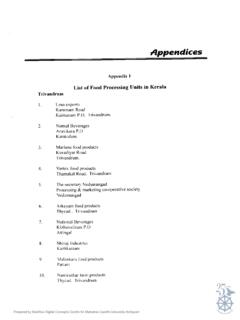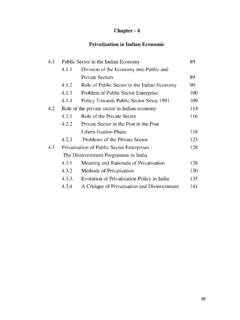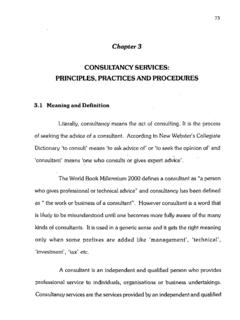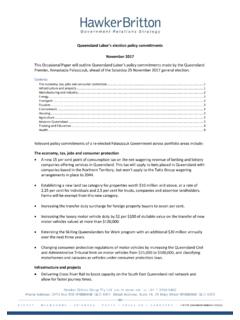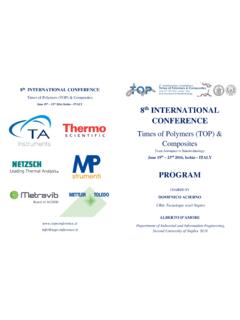Transcription of CHAPTER II LITERATURE REVIEW 2.1 Introduction
1 Page | 16 CHAPTER II LITERATURE REVIEW Introduction This CHAPTER unfolds with a REVIEW of LITERATURE on employee engagement , which includes unraveling the concept of employee engagement , employee engagement definitions, and its dimensions, antecedents of employee engagement and categories of employee engagement . The second part of this CHAPTER deals with the Organizational Culture LITERATURE , its meaning, conceptualization and dimensions. The third part of the CHAPTER deals with Organizational Communication, its meaning and dimensions.
2 The CHAPTER helps in identifying research gaps which lay the foundation for defining the research problem and building of the theoretical framework of the study. The Meaning of engagement Symbolized by the images of combat and marriage engagement is associated with the active participation and investment of an individual s whole person, not solely parts into role performance. In the context of the workplace, engagement takes on a more specific meaning. Within organizations these interactions manifest themselves in the contract of employment wherein employees pledge their services to their employer, commit themselves to their job, and undertake the obligations of employment.
3 Employees assume and embrace roles within organizations by investing their energies into these roles. In-turn they become attached to and Page | 17 are absorbed in the roles they perform. When they are emotionally and mentally engaged they take the organization to greater heights. Organizations have recently begun focusing on the level of engagement of their employees in an effort to understand the underlying factors of employee motivation and performance (Gallup, 2005). engagement with one s work is important, given that work is a pervasive and influential part of an individual s well-being, affecting not only the quality of an individual s life but one s mental and physical health as well (Wrzesniewski, Rozin, & Bennett, 2002).
4 Most people must work to earn a living, which makes work an obligation rather than a choice. However, despite this apparent lack of choice, individual experiences with work are quite diverse, ranging from work as a monotonous grind to work as an expression of one s identity (Hulin, 2002). Level of employee engagement is a predictor of both individual and organizational performance. Evolution of employee engagement Goffman (1959, 1961) was one of the first to use the term embracement to describe the investment of self and energy into one s role.
5 For Goffman, role embracement involved an admitted or expressed attachment to the role and an active engagement or spontaneous involvement in role activity; that is, a visible investment of attention and effort (Goffman, 1961) Behaviors that signify a lack of separation between a person and a role were indicative of role embracement, whereas behaviors that separated a person from a disdained role indicated role distance. To explain the concept, Goffman contrasted a police officer directing rush hour traffic, dancing with his arms and legs and blowing his whistle, as high role embracement.
6 In contrast, a Page | 18 young man expressed role distance from his merry-go-round attendant job through inattentiveness and gestures such as yawning and mock-grimacing. Using Goffman s view of role embracement, Kahn (1990) established a theoretical framework to understand when and why individuals invest varying degrees of themselves in work role performance. Through ethnographic interviews, Kahn explored engagement and disengagement among two groups of workers: counselors at a summer camp in the Caribbean and members of an architectural firm.
7 Kahn explored conditions at work where people were personally engaged, expressed and employed their personal selves, or were disengaged and withdrew and defended their personal selves. From this, Kahn developed a definition of engagement to include the simultaneous employment and expression of a person's preferred self in task behaviors that promote connections to work and to others, personal presence (physical, cognitive, and emotional) and active, full performances (Kahn, 1990). For Kahn, the individuals engagement in their role was manifested by the investment of themselves along the three dimensions.
8 Implicit in this definition is the notion that the individuals engagement is reflected by the investment of personal energies into their role, which can vary according to the contextual factors or requirements of the role. To illustrate this concept, Kahn described a scuba diving instructor who exhibited moments of engagement via all three dimensions during a diving expedition. The instructor employed himself physically, by checking gear and leading the dive; cognitively, by being vigilantly aware of divers, weather, and marine life; and emotionally, by his enthusiasm and empathy for the young divers who were both excited and fearful.
9 Conversely, personal disengagement is the uncoupling of self from role and is exhibited by a lack of physical involvement, cognitive vigilance, and emotional investment (Kahn, 1990). Page | 19 These behaviors underlie what researchers have characterized as automatic or robotic (Hochschild, 1983), burnout (Maslach, 1982), apathetic, detached (Goffman, 1959, 1961), or effortless (Hackman & Oldham, 1980). Kahn described an example of disengagement with one s role in the action and thoughts of a senior architect who assigned tasks to subordinates, adopted a perfunctory approach to work, and failed to empathize or emotionally connect with clients or draftsmen.
10 From these and other examples, Kahn determined that an individual s role engagement is reflected by a dynamic relationship in which an individual invested and divested personal energy and emotion into his or her role across the physical, emotional, and cognitive dimensions. As Kahn (1990, 1992) asserted, people exhibit engagement by harnessing themselves to their role through the investment of varying degrees of personal energies and emotions. Theoretical support for Kahn s suppositions on engagement can be found in the work of Kelman (1958), who posited that the lowest investment of personal energies into role performance is one that was solely physical, automatic, or robotic as mentioned by Hochschild, (1983) and devoid of cognitive or emotional involvement.
